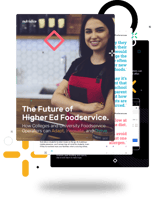Campuses are hotbeds of innovation, humming with the special kind of energy generated when a collection of smart people gather together and learn how to take on the world. More than patrons served by other foodservice industries like healthcare or senior living, students are a forward-thinking constituency—and their focus on the future doesn’t disappear when they get hungry!
College populations have high expectations around quality, transparency, and convenience. They expect to be able to navigate offerings digitally and find meals that meet their dietary needs and wants easily and from anywhere.
These expectations present a challenge for dining service operators: Not only must you keep up with off-campus competitors and manage increasingly complex operations, you must do so without extra resources to throw at these new imperatives. That’s why it’s time to take inspiration from our surroundings and lean into innovation in order to work smarter, not harder.
Let’s dig into three reasons we can’t stick to the status quo:
1. Students are Early Adopters
Students are some of the first people willing to test and embrace new trends. For example, as true digital natives, nearly two-thirds of college students say that they’d prefer using mobile apps to order their meals.
.jpg?width=400&name=Engage%20customers%20through%20professional%20quality%20digital%20signage%20menu%20boards%202018-12-14%2008-13-45%20(1).jpg) And tech isn’t the only realm in which students are trailblazers: It’s taste, too! No longer content to grab a slice of pizza every night, nearly half of students wish their school would change the menu more often to offer new foods, and 45% say that it’s important that their school is transparent about how ingredients are sourced. Whether they’re getting this information online or in-person through digital displays, students expect it to be readily accessible, allowing them to quickly filter and find what they’re looking for.
And tech isn’t the only realm in which students are trailblazers: It’s taste, too! No longer content to grab a slice of pizza every night, nearly half of students wish their school would change the menu more often to offer new foods, and 45% say that it’s important that their school is transparent about how ingredients are sourced. Whether they’re getting this information online or in-person through digital displays, students expect it to be readily accessible, allowing them to quickly filter and find what they’re looking for.
To keep up with forward-looking customer expectations, operators should prioritize flexible ordering and focus on telling a compelling story—online and in-person on digital displays—about the food they offer so that customers have a clear understanding of the passion for quality you bring to your cooking.
2. Your Competitors are Innovating...Right. Now.
Students don’t necessarily want to leave campus to find food, but off-campus restaurants are doing everything they can to make that option easy and accessible. If students have access to off-campus alternatives, you can all but guarantee that those restaurants have, among other things, tapped into the vast web of delivery and mobile order apps available to them. Students know they can go online to find out in an instant what meals are available to them, and can order them in a few quick taps.
To mitigate the possibility of losing customers to digital-friendly competitors outside of the campus ecosystem, it’s crucial to establish a strong digital footprint that allows students to see what you’re offering and to order meals on the go. By building a mobile presence that’s easy to navigate, you’ll remain top-of-mind for students, even if they’re nowhere near your facilities when a craving strikes.
3. Old Tech Can’t Match Increasing Complexity
 Your students want more, and you’ve evolved to give it to them! Whether you’re expanding the ways you serve customers by offering made-to-order meals and contactless ordering, growing the number of cafés and convenience markets they can shop in, or continuing to push your menu to new heights when it comes to variety, dietary accommodations, and more, the tools and practices that once kept your operation humming most likely aren’t up to the job anymore.
Your students want more, and you’ve evolved to give it to them! Whether you’re expanding the ways you serve customers by offering made-to-order meals and contactless ordering, growing the number of cafés and convenience markets they can shop in, or continuing to push your menu to new heights when it comes to variety, dietary accommodations, and more, the tools and practices that once kept your operation humming most likely aren’t up to the job anymore.
If you’re still relying on unintegrated systems and making manual updates, you’re sacrificing precious resources on work that could be automated or streamlined. Do any of these six common problems sound familiar? If so, your tech stack may need an upgrade:
7 Signs Your Dining Services Tech is Lagging Behind
- You have an employee whose entire job is managing digital signage or other manual workarounds you feel that you “just have to do.”
- Your systems don’t share information with each other, forcing you to manually update information in multiple places or operate with outdated or missing information.
- Your operational teams avoid working within your tech platforms because they aren’t user-friendly.
- Your current mobile ordering solution is driving your customers to off-campus options more than it’s keeping them on campus.
- You solve operational problems with one-off fixes.
- It's costing your operation unexpected budget to fix, upkeep or scale in the system.
- Your technology was purchased and installed more than four years ago.
Takeaways
Today’s higher ed dining service operators face an innovation imperative. From digital accessibility to menu variety to the sheer breadth of operational complexity required to run a modern foodservice business, operators must continue looking forward in order to adapt and thrive.

To learn more about how you can win the future of customer service, download our free eBook, The Future of Higher Ed Foodservice.
Or, check out our Higher Ed solutions page to see how Nutrislice can help you provide students and staff the meals they love to enjoy.

